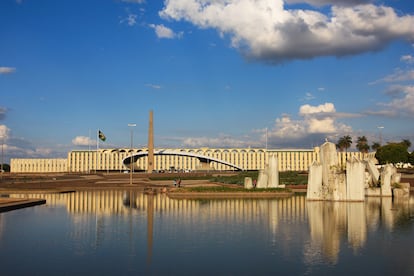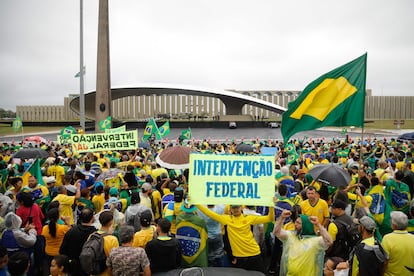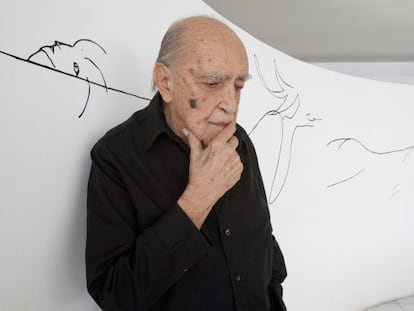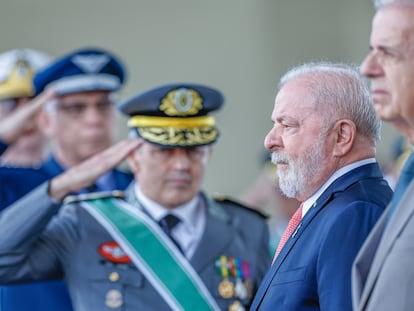Communist Oscar Niemeyer, the military generals and Brasília’s forgotten palace
The Army Headquarters, where the coup leaders came out a year ago to oppose President Lula da Silva, was built by Brazil’s most universal architect during the worst years of the dictatorship


The delicate white buildings that architect Oscar Niemeyer (1907-2012) designed for the headquarters of the three branches of government in Brasília were easy prey for the Bolsonaro’s supporters on January 8, 2023. The mob nimbly climbed the ramps. In no time at all, they swept away the glass facades. The coup plotters had departed that Sunday morning from Army Headquarters, another architectural complex designed by Brazil’s most international architect. When Niemeyer, a proud communist, was commissioned to create the new capital’s main public buildings, the task included designing the seat of military power. Remarkably, the monumental barracks with curved shapes and reinforced concrete was built between 1968 and 1973, during the most repressive years of a fiercely anti-communist dictatorship. Cold War stuff. Since then, the building has served as the army’s headquarters. Perhaps that is why it is a largely forgotten (or ignored) work among the vast legacy of the Brazilian. Few in Brazil know the history of the building.
They say that Niemeyer fondly remembered the camaraderie between the workers and engineers during the futuristic capital’s construction in the 1950s. “On inauguration day [in 1961], everything changed with the president, the generals, the deputies, all the high officials and their high society ladies. The magic was suddenly broken,” he lamented. The military perpetrated a coup in 1964 and shut down the Congress in 1968 with decree AI5.
Last Tuesday, a lone private stood guard at the barracks’ great defining characteristic, a 12-meter-high curved acoustic shell. It protects the authorities during parades and has an impressive echo. In front, there’s a six-lane avenue that Niemeyer designed for a military parade. For two months, before Lula assumed the presidency, Bolsonaro’s supporters occupied the place and demanded military intervention to prevent the leftist leader’s return to power. A few steps away, there’s a theater with a corrugated roof where the Brasilia Symphony Orchestra performs. The Army rents it for events.

Visitors are prohibited from entering the rest of the complex, two huge rectangular office blocks. That morning, two pairs of tourists walked through the gardens while a squadron of fighter jets flew over a deep blue sky dotted with fluffy clouds.
Anyone familiar with Niemeyer’s work can immediately recognize his hand in the barracks. The Army — where former president Jair Bolsonaro cut his teeth and where he has a bastion of henchmen — does not hide the fact that the building was designed by one of Brazil’s most famous communists, although they don’t boast about it either. The day after the uprising, the police removed the encampment and arrested over a thousand people.
The relationship between Niemeyer and the military was contradictory and full of ups and downs. That’s not unusual. After all, Brazil is the country where the military regime wanted musicians Caetano Veloso and Gilberto Gil exiled far away but accepted the artists’ proposal to hold a last concert to raise funds before leaving for London. Veloso tells that story in his autobiography, Verdade tropical.
“It’s an iconic building,” architect Bruno Campos, who dedicated his master’s thesis to the Army Headquarters, explains in a video call interview. “Niemeyer proposed it as a palace. The idea was that each branch would have its own.” Planalto would be for the president; Alvorada, the president’s official residence; Itamaraty, the headquarters of the Foreign Ministry; the Supreme Court and the Congress. For the Catholic Church, Niemeyer built a peculiar cathedral, the bells of which were donated by Spanish dictator Francisco Franco.
“It is a work [that’s] very hidden in the historiography. I imagine [that’s] because it was built during the dictatorship, because it is not very accessible and because it is a symbol of the Armed Forces,” Campos explains. “A colonel got permission for me to enter a room in the [barracks] library where they keep the original plans, it’s a very rich archive.”

Although the barracks’ label as a palace did not survive the tensions of the period, the University of Brasilia researcher defends its inclusion on this list for several reasons: the rational construction system, the prefabricated elements, and, like the architect’s other emblematic works, gardens by the landscape architect Burle Marx and a panel of tiles by Athos Bulcão.
By 1964, the year the coup d’état took place, Niemeyer was already an established professional, but he employed anti-American discourse that the Armed Forces didn’t like. He praised the Chilean socialist Salvador Allende and wrote letters in defense of democracy and articles in which he proclaimed: “I am a true communist.” A friend of Fidel Castro and Hugo Chávez, he never missed an opportunity to criticize inequality and injustice. Niemeyer was spied on and interrogated like other Brazilian opponents, but he was never arrested. The military lacked the courage, his friends said.
Campos was interested in the building but also intrigued by the historical moment in which it was built. The architect and the generals swallowed their mutual misgivings and collaborated for much of the work on the General Headquarters, although Niemeyer had already gone into exile in Paris. Angered by repeated delays, the Army abruptly pushed him aside. “He lost control of the project,” Campos recounts. The Niemeyer Foundation did not respond to requests for its version of this period.
The most commonly remembered and repeated episode about Niemeyer during the dictatorship (1964-1985) is his dispute with the generals over Brasilia’s future airport. The architect designed a circular airfield, which the military flatly rejected: it had to be rectangular. The men in uniform won the battle. He also had a falling out with the Catholic Church. The bishop of Belo Horizonte refused to consecrate the Pampulha church because an atheist had designed it.
In a particularly hurtful gesture, the dictatorship accused Niemeyer of the worst crime an artist can commit: plagiarism. This is how Niemeyer recalled it in his memoirs, As curvas do tempo: “The indignity reached unimaginable limits when Colonel Manso Neto created a sketch with which he attempted to demonstrate that I copied Le Corbusier.” He was angry when the rumor reached the powerful circles in which he used to move so well. He worked with the Frenchman on the international team that designed the UN headquarters in New York.

After the airport disagreement, a senior commander proclaimed, “The home of a communist architect is in Moscow.” Niemeyer understood that it was time to leave; he did not go to the USSR but to Paris.
By then, the police had raided his studio and the architectural magazine he edited, Modulo. Along with over 200 professors, Niemeyer resigned from the University of Brasilia in protest against the military regime. As he lost commissions in his homeland, exile became an opportunity. He seized it.
The Brazilian architect designed the iconic headquarters of the French Communist Party, the Mondadori publishing house in Milan (inspired by the Itamaraty chancellery in Brasilia), universities in Algiers... His international reputation skyrocketed. With Niemeyer’s growing prestige, Brazilian architecture entered the world elite.
As in other projects, Niemeyer appointed another architect to head the day-to-day management of the Barracks project. He chose his former son-in-law Carlos Magalhães, whom Campos interviewed for his thesis. “He was indeed arrested during the dictatorship. He told me that he was released through the mediation of the archbishop, whom he knew from the cathedral project.”
Magalhães told him an anecdote that may illustrate the Brazilian character. In the 1980s, the Army awarded Magalhães the Peacemaker medal for services rendered during the construction of its monumental headquarters. In solidarity with his beleaguered colleagues, the architect declined to receive it in a public ceremony. Instead, the military got it to him discreetly in a small box; they delivered it to him in a barracks hallway, without fanfare.
Niemeyer’s visits to Brazil during the dictatorship became more frequent as democracy took hold. He continued to create tirelessly in his studio on Copacabana beach. Anyone who travels through urban Brazil comes across these emblematic and easily recognizable forms all over the place. He created the Sambadrome in Rio de Janeiro, a rodeo stadium for Brazilian cowboys, a museum in the shape of a flying saucer-shaped overlooking Guanabara Bay and much more... At the age of 99, he married for the second time. He was 103 when he gave the Niemeyer cultural center to Avilés (in Spain). The atheist who created churches, the communist who built the Army Headquarters, died at 104.
Sign up for our weekly newsletter to get more English-language news coverage from EL PAÍS USA Edition
Tu suscripción se está usando en otro dispositivo
¿Quieres añadir otro usuario a tu suscripción?
Si continúas leyendo en este dispositivo, no se podrá leer en el otro.
FlechaTu suscripción se está usando en otro dispositivo y solo puedes acceder a EL PAÍS desde un dispositivo a la vez.
Si quieres compartir tu cuenta, cambia tu suscripción a la modalidad Premium, así podrás añadir otro usuario. Cada uno accederá con su propia cuenta de email, lo que os permitirá personalizar vuestra experiencia en EL PAÍS.
¿Tienes una suscripción de empresa? Accede aquí para contratar más cuentas.
En el caso de no saber quién está usando tu cuenta, te recomendamos cambiar tu contraseña aquí.
Si decides continuar compartiendo tu cuenta, este mensaje se mostrará en tu dispositivo y en el de la otra persona que está usando tu cuenta de forma indefinida, afectando a tu experiencia de lectura. Puedes consultar aquí los términos y condiciones de la suscripción digital.
More information
Archived In
Últimas noticias
Most viewed
- Sinaloa Cartel war is taking its toll on Los Chapitos
- Oona Chaplin: ‘I told James Cameron that I was living in a treehouse and starting a permaculture project with a friend’
- Reinhard Genzel, Nobel laureate in physics: ‘One-minute videos will never give you the truth’
- Why the price of coffee has skyrocketed: from Brazilian plantations to specialty coffee houses
- Silver prices are going crazy: This is what’s fueling the rally










































